Abstract
The preparation and properties of a partially succinoylated cytochrome c, suited for the detection of superoxide anion radicals in liver microsomes, is reported. By succinoylation of 45% of the primary amino groups of horse heart cytochrome c the activity towards solubilized NADPH--cytochrome P-450 reductase was diminished by 99% compared with native cytochrome c. The capacities of cytochrome b5 and cytochrome c oxidase to reduce the succinoylated ferricytochrome c and oxidize succinoylated ferrocytochrome c respectively were decreased to a similar extent. However, the bimolecular rate constant for the reduction of the partially succinoylated ferricytochrome c by O2-. was estimated to be one-tenth of the value for the reaction of O2-. with native ferricytochrome c a pH 7.7. On this basis the quantification of O2-. generated by NADPH-supplemented liver microsomes became possible. The initial rates of succinoylated ferricytochrome c reduction determined at various finite concentrations of the cytochrome c derivative can be extrapolated to obtain true rates of O2-. generation in a homogeneous system. The problems encountered in the quantitative determination of O2-. produced in biological membranes, e.g. microsomes, are discussed.
Full text
PDF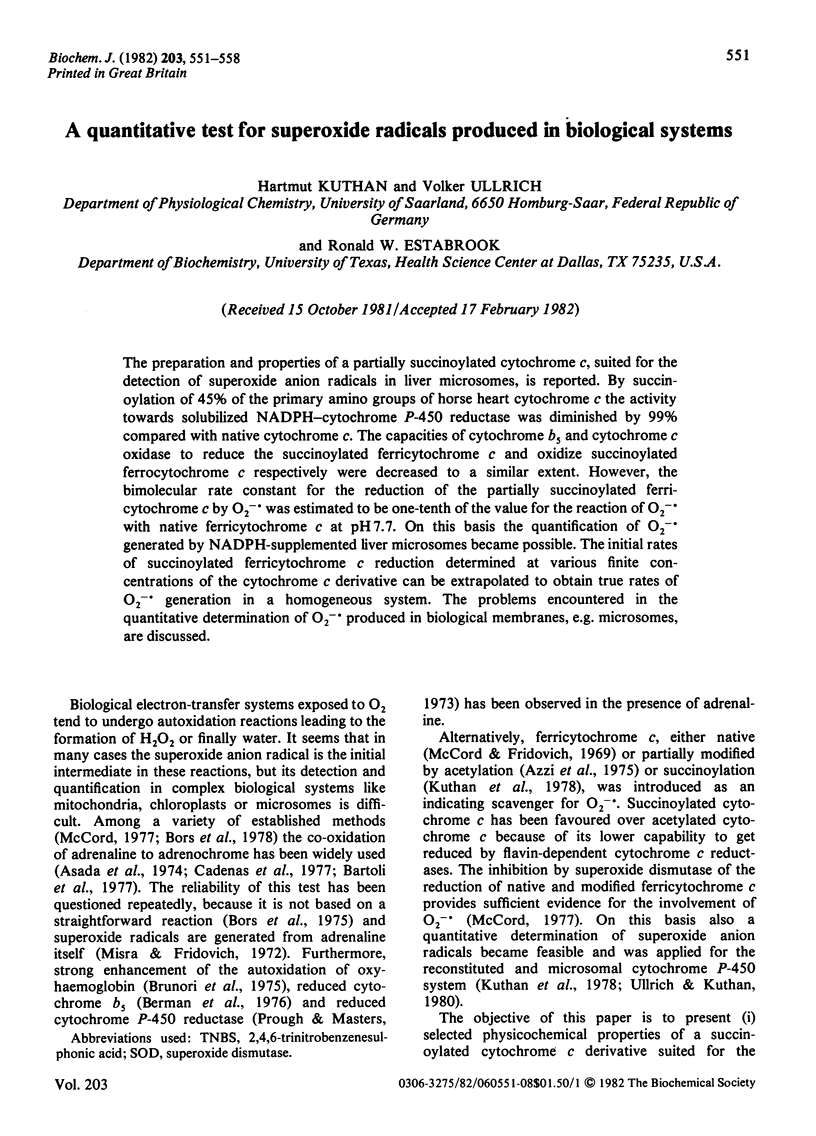
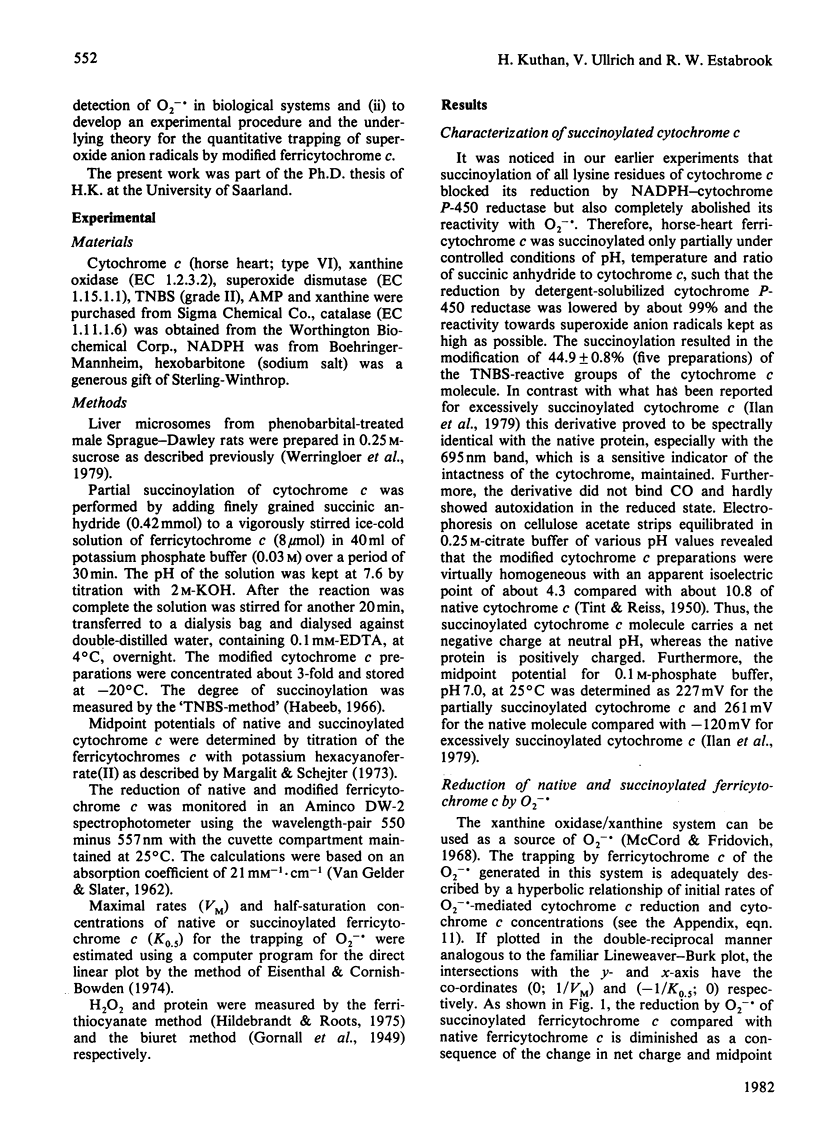
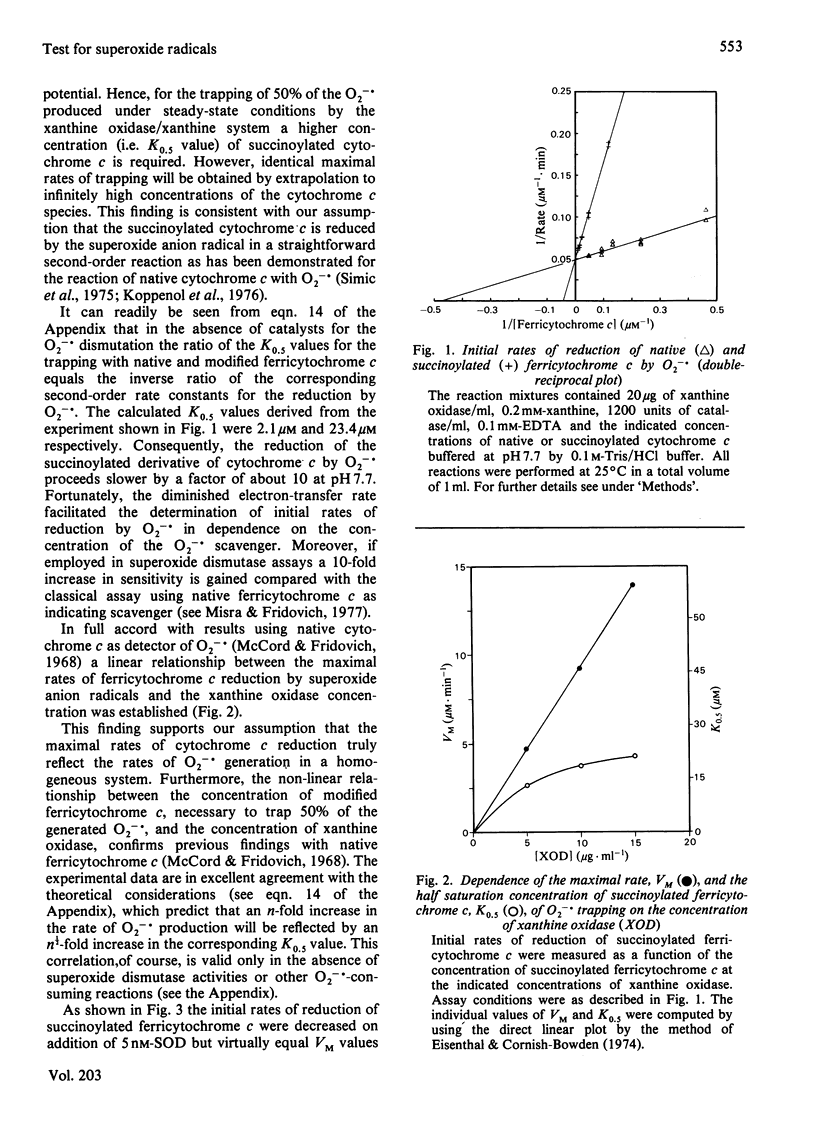

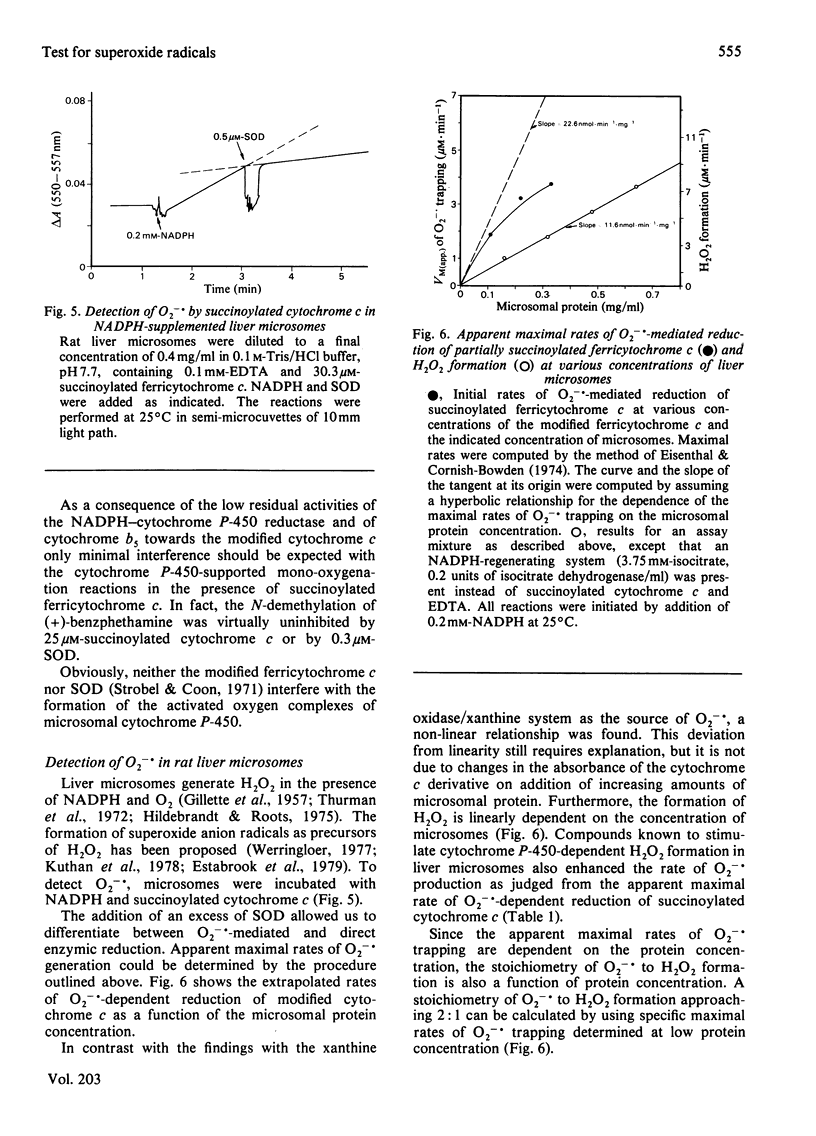
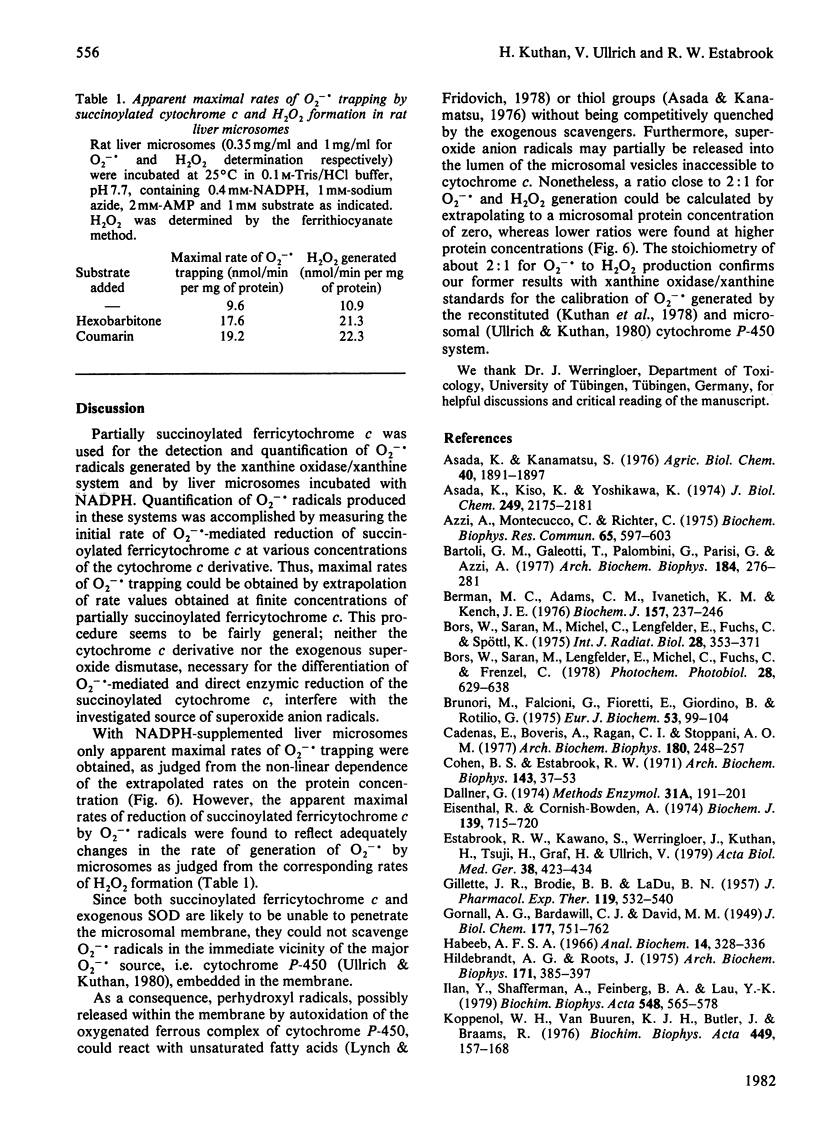
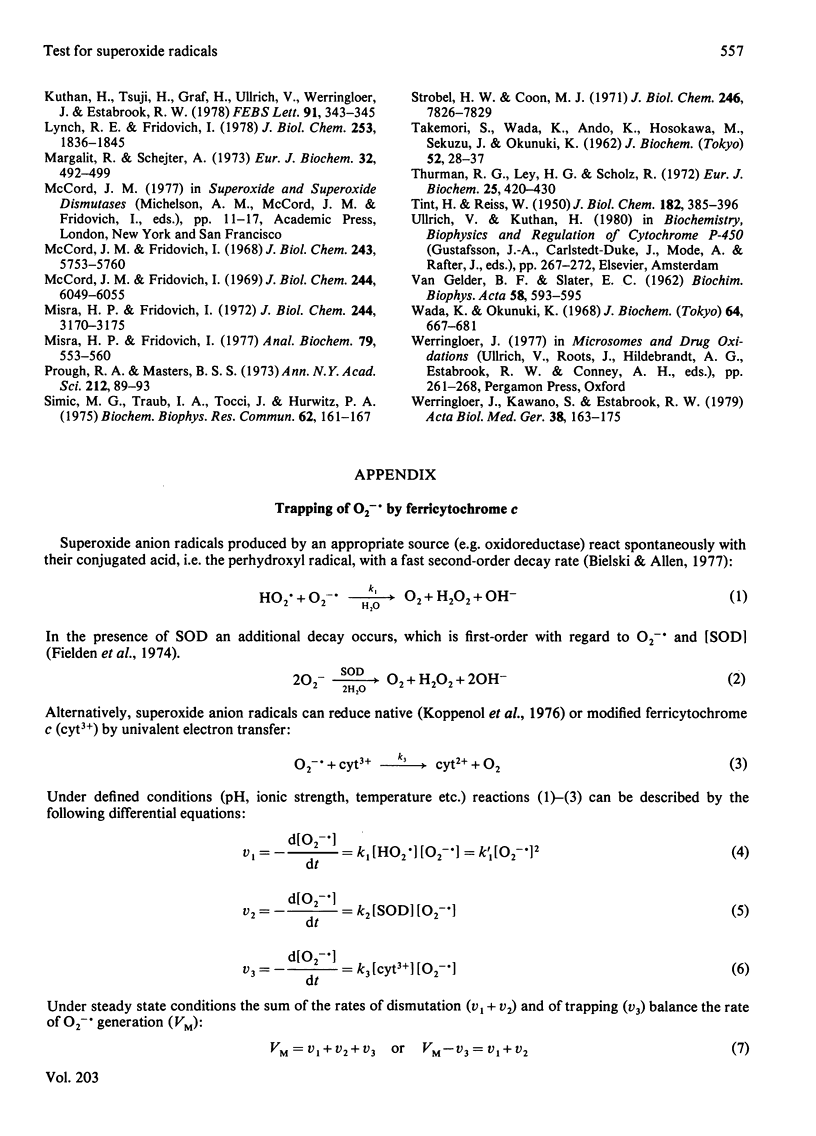
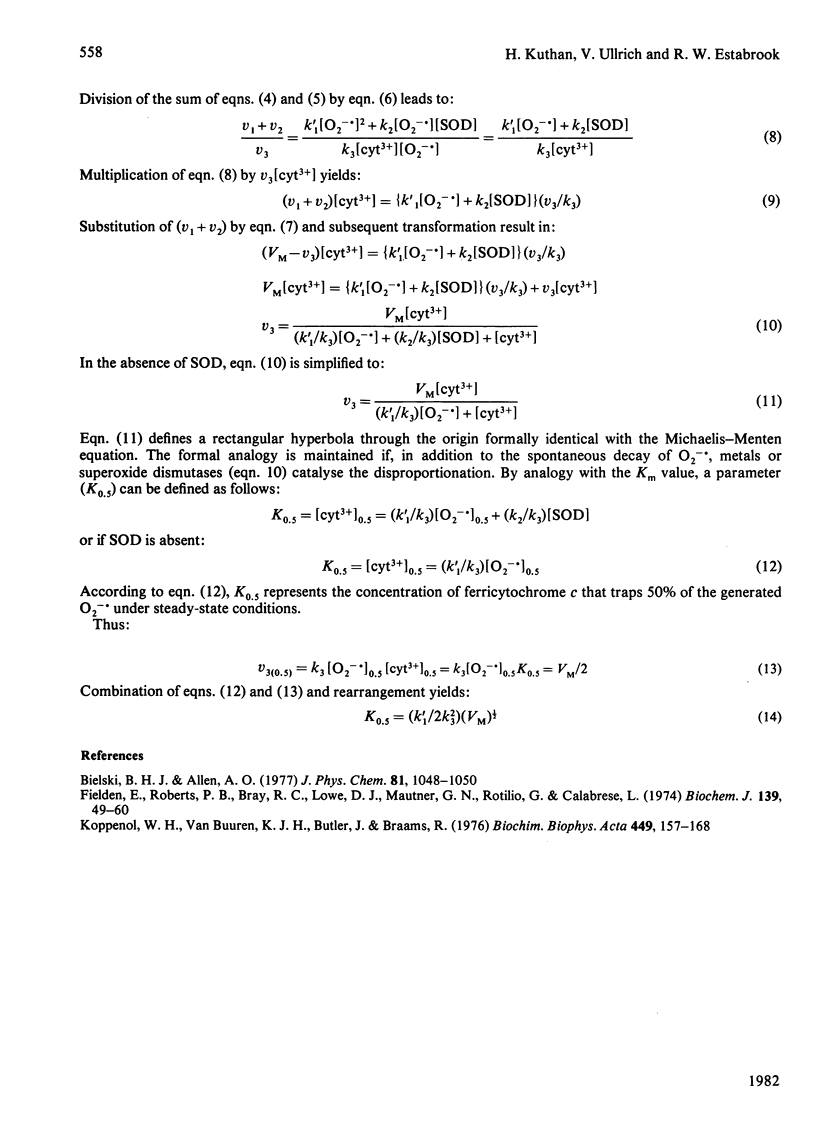
Selected References
These references are in PubMed. This may not be the complete list of references from this article.
- Asada K., Kiso K., Yoshikawa K. Univalent reduction of molecular oxygen by spinach chloroplasts on illumination. J Biol Chem. 1974 Apr 10;249(7):2175–2181. [PubMed] [Google Scholar]
- Azzi A., Montecucco C., Richter C. The use of acetylated ferricytochrome c for the detection of superoxide radicals produced in biological membranes. Biochem Biophys Res Commun. 1975 Jul 22;65(2):597–603. doi: 10.1016/s0006-291x(75)80188-4. [DOI] [PubMed] [Google Scholar]
- Bartoli G. M., Galeotti T., Palombini G., Parisi G., Azzi A. Different contribution of rat liver microsomal pigments in the formation of superoxide anions and hydrogen peroxide during development. Arch Biochem Biophys. 1977 Nov;184(1):276–281. doi: 10.1016/0003-9861(77)90351-4. [DOI] [PubMed] [Google Scholar]
- Berman M. C., Adnams C. M., Ivanetich K. M., Kench J. E. Autoxidation of soluble trypsin-cleaved microsomal ferrocytochrome b5 and formation of superoxide radicals. Biochem J. 1976 Jul 1;157(1):237–246. doi: 10.1042/bj1570237. [DOI] [PMC free article] [PubMed] [Google Scholar]
- Bors W., Saran M., Lengfelder E., Michel C., Fuchs C., Frenzel C. Detection of oxygen radicals in biological reactions. Photochem Photobiol. 1978 Oct-Nov;28(4-5):629–638. doi: 10.1111/j.1751-1097.1978.tb06982.x. [DOI] [PubMed] [Google Scholar]
- Bors W., Saran M., Michel C., Lengfelder E., Fuchs C., Spöttl R. Pulse-radiolytic investigations of catechols and catecholamines. I. Adrenaline and adrenochrome. Int J Radiat Biol Relat Stud Phys Chem Med. 1975 Oct;28(4):353–371. doi: 10.1080/09553007514551141. [DOI] [PubMed] [Google Scholar]
- Cadenas E., Boveris A., Ragan C. I., Stoppani A. O. Production of superoxide radicals and hydrogen peroxide by NADH-ubiquinone reductase and ubiquinol-cytochrome c reductase from beef-heart mitochondria. Arch Biochem Biophys. 1977 Apr 30;180(2):248–257. doi: 10.1016/0003-9861(77)90035-2. [DOI] [PubMed] [Google Scholar]
- Cohen B. S., Estabrook R. W. Microsomal electron transport reactions. II. The use of reduced triphosphopyridine nucleotide and-or reduced diphosphopyridine nucleotide for the oxidative N-demethylation of aminopyrine and other drug substrates. Arch Biochem Biophys. 1971 Mar;143(1):46–53. doi: 10.1016/0003-9861(71)90184-6. [DOI] [PubMed] [Google Scholar]
- Dallner G. Isolation of rough and smooth microsomes--general. Methods Enzymol. 1974;31:191–201. [PubMed] [Google Scholar]
- Eisenthal R., Cornish-Bowden A. The direct linear plot. A new graphical procedure for estimating enzyme kinetic parameters. Biochem J. 1974 Jun;139(3):715–720. doi: 10.1042/bj1390715. [DOI] [PMC free article] [PubMed] [Google Scholar]
- Estabrook R. W., Kawano S., Werringloer J., Kuthan H., Tsuji H., Graf H., Ullrich V. Oxycytochrome P-450: its breakdown to superoxide for the formation of hydrogen peroxide. Acta Biol Med Ger. 1979;38(2-3):423–434. [PubMed] [Google Scholar]
- Fielden E. M., Roberts P. B., Bray R. C., Lowe D. J., Mautner G. N., Rotilio G., Calabrese L. Mechanism of action of superoxide dismutase from pulse radiolysis and electron paramagnetic resonance. Evidence that only half the active sites function in catalysis. Biochem J. 1974 Apr;139(1):49–60. doi: 10.1042/bj1390049. [DOI] [PMC free article] [PubMed] [Google Scholar]
- GILLETTE J. R., BRODIE B. B., LA DU B. N. The oxidation of drugs by liver microsomes: on the role of TPNH and oxygen. J Pharmacol Exp Ther. 1957 Apr;119(4):532–540. [PubMed] [Google Scholar]
- Habeeb A. F. Determination of free amino groups in proteins by trinitrobenzenesulfonic acid. Anal Biochem. 1966 Mar;14(3):328–336. doi: 10.1016/0003-2697(66)90275-2. [DOI] [PubMed] [Google Scholar]
- Hildebraunt A. G., Roots I. Reduced nicotinamide adenine dinucleotide phosphate (NADPH)-dependent formation and breakdown of hydrogen peroxide during mixed function oxidation reactions in liver microsomes. Arch Biochem Biophys. 1975 Dec;171(2):385–397. doi: 10.1016/0003-9861(75)90047-8. [DOI] [PubMed] [Google Scholar]
- Ilan Y., Shafferman A., Feinberg B. A., Lau Y. K. Partitioning of electrostatic and conformational contributions in the redox reactions of modified cytochromes c. Biochim Biophys Acta. 1979 Dec 6;548(3):565–578. doi: 10.1016/0005-2728(79)90065-3. [DOI] [PubMed] [Google Scholar]
- Koppenol W. H., van Buuren K. J., Butler J., Braams R. The kinetics of the reduction of cytochrome c by the superoxide anion radical. Biochim Biophys Acta. 1976 Nov 9;449(2):157–168. doi: 10.1016/0005-2728(76)90130-4. [DOI] [PubMed] [Google Scholar]
- Koppenol W. H., van Buuren K. J., Butler J., Braams R. The kinetics of the reduction of cytochrome c by the superoxide anion radical. Biochim Biophys Acta. 1976 Nov 9;449(2):157–168. doi: 10.1016/0005-2728(76)90130-4. [DOI] [PubMed] [Google Scholar]
- Kuthan H., Tsuji H., Graf H., Ullrich V. Generation of superoxide anion as a source of hydrogen peroxide in a reconstituted monooxygenase system. FEBS Lett. 1978 Jul 15;91(2):343–345. doi: 10.1016/0014-5793(78)81206-x. [DOI] [PubMed] [Google Scholar]
- Lynch R. E., Fridovich I. Effects of superoxide on the erythrocyte membrane. J Biol Chem. 1978 Mar 25;253(6):1838–1845. [PubMed] [Google Scholar]
- Margalit R., Schejter A. Cytochrome c: a thermodynamic study of the relationships among oxidation state, ion-binding and structural parameters. 1. The effects of temperature, pH and electrostatic media on the standard redox potential of cytochrome c. Eur J Biochem. 1973 Feb 1;32(3):492–499. doi: 10.1111/j.1432-1033.1973.tb02633.x. [DOI] [PubMed] [Google Scholar]
- McCord J. M., Fridovich I. Superoxide dismutase. An enzymic function for erythrocuprein (hemocuprein). J Biol Chem. 1969 Nov 25;244(22):6049–6055. [PubMed] [Google Scholar]
- McCord J. M., Fridovich I. The reduction of cytochrome c by milk xanthine oxidase. J Biol Chem. 1968 Nov 10;243(21):5753–5760. [PubMed] [Google Scholar]
- Misra H. P., Fridovich I. Superoxide dismutase: "positive" spectrophotometric assays. Anal Biochem. 1977 May 1;79(1-2):553–560. doi: 10.1016/0003-2697(77)90429-8. [DOI] [PubMed] [Google Scholar]
- Misra H. P., Fridovich I. The role of superoxide anion in the autoxidation of epinephrine and a simple assay for superoxide dismutase. J Biol Chem. 1972 May 25;247(10):3170–3175. [PubMed] [Google Scholar]
- Prough R. A., Masters B. S. Studies on the NADPH oxidase reaction of NADPH-cytochrome C reductase. I. The role of superoxide anion. Ann N Y Acad Sci. 1973;212:89–93. doi: 10.1111/j.1749-6632.1973.tb47588.x. [DOI] [PubMed] [Google Scholar]
- Simic M. G., Taub I. A., Tocci J., Hurwitz P. A. Free radical reduction of ferricytochrome-C. Biochem Biophys Res Commun. 1975 Jan 20;62(2):161–167. doi: 10.1016/s0006-291x(75)80118-5. [DOI] [PubMed] [Google Scholar]
- Strobel H. W., Coon M. J. Effect of superoxide generation and dismutation on hydroxylation reactions catalyzed by liver microsomal cytochrome P-450. J Biol Chem. 1971 Dec 25;246(24):7826–7829. [PubMed] [Google Scholar]
- TAKEMORI S., WADA K., ANDO K., HOSOKAWA M., SEKUZU I., OKUNUKI K. Studies on cytochrome a. VIII. Reaction of cytochrome a with chemically modified cytochrome c and basic proteins. J Biochem. 1962 Jul;52:28–37. doi: 10.1093/oxfordjournals.jbchem.a127568. [DOI] [PubMed] [Google Scholar]
- Thurman R. G., Ley H. G., Scholz R. Hepatic microsomal ethanol oxidation. Hydrogen peroxide formation and the role of catalase. Eur J Biochem. 1972 Feb;25(3):420–430. doi: 10.1111/j.1432-1033.1972.tb01711.x. [DOI] [PubMed] [Google Scholar]
- Wada K., Okunuki K. Studies on chemically modified cytochrome c. I. The acetylated cytochrome c. J Biochem. 1968 Nov;64(5):667–681. doi: 10.1093/oxfordjournals.jbchem.a128945. [DOI] [PubMed] [Google Scholar]
- Werringloer J., Kawano S., Estabrook R. W. Spin state transitions of liver microsomal cytochrome P-450. Acta Biol Med Ger. 1979;38(2-3):163–175. [PubMed] [Google Scholar]
- van GELDER B., SLATER E. C. The extinction coefficient of cytochrome c. Biochim Biophys Acta. 1962 Apr 23;58:593–595. doi: 10.1016/0006-3002(62)90073-2. [DOI] [PubMed] [Google Scholar]


